Oh sure, there are the “power users” who are encoding video or compiling Xcode. I’ll give you that. These are the guys extolling the M1 virtues all this week in online forums and YouTube. And they happen to be the taste makers and influencers of conventional wisdom. But this is a tiny subset of computer users.
Probably over 90% of computers sold end up in either a home setting where consumers pay bills or in the enterprise world where it’s not much more than a dumb terminal. The power of the M1 will basically be irrelevant to people surfing the web or reading e-mail.
My wife is a freelance editor who just transitioned from using a 2012 13” Retina MacBook Pro to the new M1 Powered Mac Mini. The step up in performance is like getting off your bicycle and getting into a Ferrari. But outside of noticing that opening and closing apps is now snappier, there is negligible impact on her workflow. Why? Because she has no need for CPU or GPU power in order to edit tiny Microsoft Word files all day.
If I hadn’t been droning on and on about the magnificence of the new M1 architecture all week, my wife would have never known the difference. She would simply do her typical work with no recognition that there was any thing different under the hood of her new Mac.
I applaud Apple’s efforts at revolutionizing the computer world. But for the average user it’s not going to make much difference on the performance front.
It’s really a similar situation that automakers have faced for years with sports cars with one major twist I’ll explain later. Speed doesn’t sell and it has low gross margins.
Consumers in the auto world have repeatedly demonstrated that they aren’t willing to pay more for speed when they are constrained by traffic and speed limits everywhere. BMW, McLaren, or Corvette enthusiasts may be willing to purchase high-powered sports cars in order to compete in their club events held at closed courses. But otherwise, all of that power and performance is wasted and consumers don’t see it as necessary. SUV’s are soundly trouncing sedans not due to superior speed and handling, but due to enhanced utility.
It’s one reason why EV makers are beating the wrong drum if they want to connect with potential car buyers. Don’t tout the acceleration benefits of an EV, you need to brag about the reliability and quality benefits (unless you’re Tesla and make dreadful vehicles).
Coming back to laptops. Outside of a tiny group of content creators, who needs a laptop that can crunch multiple 4K video streams simultaneously? I know I don’t. Most people aren’t going to peg the upper limit of the M1 chip in their new Mac Minis any more than they are going to hit 180mph on their way to work in their Corvette Stingray. Above a certain level, performance becomes irrelevant.
The big twist I alluded to earlier is that the high performance “low end” devices that Apple is now selling probably cost LESS to make than they did before. It must cost much less to manufacture those new laptops with M1 chips than it would to buy separate components and solder it all together on the circuit board. Customers are not faced with the decision of “do I want to pay more for this blazing performance?” My wife’s Mac Mini cost less than my Apple Watch.
In the auto world, high performance cars tend to cost much more to make due to lower volume powertrains. Someone who wants the performance of the new mid-engined Corvette Stingray has to consciously decide it’s worth a $30K premium over that 4-door Impala.
The real reason that Apple is transitioning to ARM chips away from Intel is cost-savings, not performance. The performance enhancement is a fortuitous consequence but it was never the main objective.
Boosting performance benefits maybe 10% of the Mac market who really pushes these machines. But preventing price increases, or even cutting prices like they did with my wife’s Mac Mini, that benefits everyone.



 RSS Feed
RSS Feed